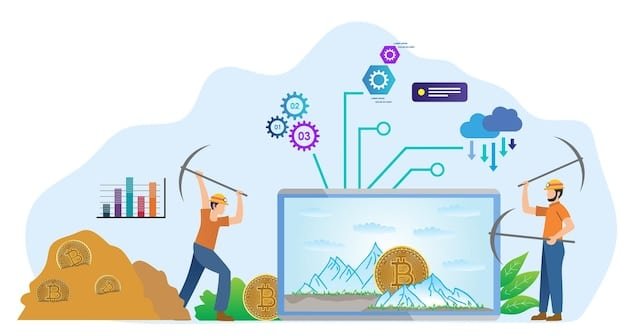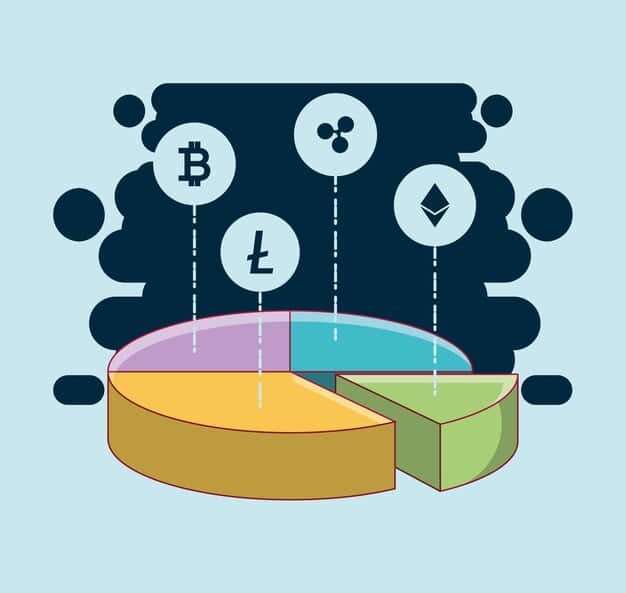Crypto Mining Pools: Boost Your Rewards by Joining Forces

Crypto mining pools unite miners to combine computational power, increasing their chances of solving complex algorithms and earning cryptocurrency rewards, which are then distributed among the participants based on their contribution.
Navigating the world of cryptocurrency mining can often feel like a solitary quest, but what if there was a way to increase your chances of success? Crypto mining pools offer just that – a collaborative approach where miners combine their resources to boost their earning potential.
Understanding Crypto Mining Pools
In the early days of cryptocurrency, solo mining was a viable option for many. However, as the difficulty of mining increased, individual miners found it increasingly challenging to compete. This led to the emergence of crypto mining pools, where miners pool their computational resources to increase their chances of solving blocks and earning rewards.
What is a Crypto Mining Pool?
A crypto mining pool is a collaborative effort among cryptocurrency miners who combine their computing power to increase their chances of finding a block. When a pool successfully mines a block, the reward is distributed among the participants based on their contribution to the pool’s overall hash rate.
Why Join a Mining Pool?
Joining a mining pool offers several advantages over solo mining. It provides a more consistent stream of income, reduces the variance in earnings, and allows smaller miners to participate effectively in the mining process. Without a mining pool, individual miners with limited resources would struggle to compete with larger mining operations.

- Increased Earning Potential: By combining resources, miners in a pool have a higher chance of solving blocks and earning rewards.
- Consistent Income: Mining pools provide a more predictable stream of income compared to the unpredictable nature of solo mining.
- Reduced Variance: The risk of not finding a block for extended periods is reduced, providing more stable earnings.
- Access to Resources: Pools often provide resources and support, making it easier for newcomers to get started.
In summary, crypto mining pools have become essential for most individual miners seeking to participate in cryptocurrency mining effectively and consistently. By joining forces, they can collectively increase their chances of earning rewards that would be difficult to achieve on their own.
How Crypto Mining Pools Work
The inner workings of a crypto mining pool involve a complex interplay of technology and algorithms. Understanding this process can help miners make informed decisions about which pools to join and how to optimize their participation.
The Role of Hash Rate
Hash rate is a crucial factor in crypto mining, representing the computational power used to solve complex cryptographic problems. In a mining pool, the combined hash rate determines the pool’s overall chances of finding a block. The higher the hash rate, the greater the probability of success.
Reward Distribution Methods
Different mining pools employ various methods for distributing rewards among participants. Some common methods include:
- Pay-Per-Share (PPS): Miners are paid a fixed amount for each share they contribute, regardless of whether the pool finds a block.
- Full Pay-Per-Share (FPPS): Similar to PPS, but includes transaction fees in the reward distribution.
- Proportional: Rewards are distributed proportionally based on the amount of work contributed during a mining round.
- Score-Based: A more complex system that factors in the timing of contributions, giving more weight to recent work.

In conclusion, the efficiency and profitability of a crypto mining pool depend on its overall hash rate and the method used to distribute rewards. Miners should carefully consider these factors when choosing a pool to maximize their earnings.
Choosing the Right Crypto Mining Pool
Selecting the right crypto mining pool is a critical decision that can significantly impact a miner’s profitability and overall experience. Several factors should be considered to ensure the pool aligns with your goals and preferences.
Factors to Consider
When evaluating crypto mining pools, consider the following factors:
- Pool Size: Larger pools tend to find blocks more frequently but may offer smaller individual rewards due to higher participation.
- Fees: Pools charge fees for their services, which can vary significantly. Compare fees to ensure they are reasonable.
- Payment Methods: Different pools offer various payment methods. Choose one that suits your preferences and minimizes transaction costs.
- Server Location: Opt for a pool with servers located close to your mining hardware to reduce latency and improve efficiency.
Research and Due Diligence
Before joining a mining pool, conduct thorough research and due diligence:
- Read Reviews: Look for reviews and feedback from other miners to gauge the pool’s reputation and reliability.
- Check Uptime: Ensure the pool has a high uptime rate to minimize downtime and maximize mining opportunities.
- Verify Security: Confirm that the pool has robust security measures in place to protect against attacks and theft.
- Test the Waters: Consider starting with a smaller investment to test the pool’s performance before committing significant resources.
In summary, choosing the right crypto mining pool requires careful consideration of various factors, including pool size, fees, payment methods, and server location. Thorough research and due diligence can help miners make informed decisions and maximize their mining potential.
Popular Crypto Mining Pools
Several crypto mining pools have gained popularity due to their reliability, performance, and features. Here are some of the most well-known pools in the cryptocurrency mining community.
Top Mining Pools
Some of the most popular mining pools include:
- Antpool: One of the largest Bitcoin mining pools, known for its high hash rate and stable performance.
- F2Pool: Another major Bitcoin mining pool with a global presence and a reputation for consistent rewards.
- ViaBTC: A versatile pool that supports multiple cryptocurrencies and offers various payment options.
- Slush Pool: The oldest Bitcoin mining pool, known for its transparency and community-focused approach.
Features and Benefits
Each of these mining pools offers unique features and benefits:
- Antpool: High hash rate, advanced monitoring tools, and a user-friendly interface.
- F2Pool: Global server network, support for multiple cryptocurrencies, and competitive fees.
- ViaBTC: Multiple cryptocurrency support, flexible payment options, and a referral program.
- Slush Pool: Transparent operations, community support, and educational resources.
In conclusion, these popular crypto mining pools offer a range of options for miners looking to join a collaborative mining effort. Each pool has its strengths and weaknesses, so it’s important to assess them based on individual mining goals and preferences.
Setting Up Your Mining Hardware
Before joining a crypto mining pool, you need to set up your mining hardware properly. This process involves selecting the right equipment, configuring it correctly, and ensuring it operates efficiently.
Choosing the Right Hardware
The type of hardware you need depends on the cryptocurrency you plan to mine. Common options include:
- ASICs (Application-Specific Integrated Circuits): These are specialized mining machines designed for specific algorithms.
- GPUs (Graphics Processing Units): GPUs are versatile and can be used to mine various cryptocurrencies.
- CPUs (Central Processing Units): CPUs are less efficient for mining but can be used for certain cryptocurrencies.
Configuration and Optimization
Once you have your hardware, follow these steps to configure it:
- Install Mining Software: Download and install the appropriate mining software for your hardware and cryptocurrency.
- Configure Mining Settings: Enter your pool details, wallet address, and other necessary settings.
- Monitor Performance: Keep an eye on your hardware’s performance to ensure it is running efficiently and effectively.
In summary, setting up your mining hardware correctly is essential for participating in a crypto mining pool. Selecting the right equipment, configuring it properly, and monitoring its performance can optimize your mining efforts and maximize your rewards.
Maximizing Your Mining Rewards
Once you’ve joined a crypto mining pool and set up your hardware, there are several strategies you can use to maximize your mining rewards. These include optimizing your hardware, monitoring performance, and staying informed about pool updates.
Optimization Strategies
To increase your mining rewards, consider the following tips:
- Overclocking: Overclocking your hardware can increase its hash rate, but be careful not to overheat or damage your equipment.
- Cooling: Proper cooling is essential to prevent overheating and maintain optimal performance.
- Software Updates: Keep your mining software up to date to take advantage of the latest features and bug fixes.
Monitoring Performance
Regularly monitor your mining hardware and pool performance to identify any issues and optimize your settings:
- Hash Rate: Monitor your hash rate to ensure it is consistent and within the expected range.
- Pool Statistics: Keep an eye on the pool’s block finding rate, reward distribution, and other relevant statistics.
- Temperature: Monitor your hardware’s temperature to prevent overheating and potential damage.
In conclusion, maximizing your mining rewards in a crypto mining pool requires ongoing effort and attention to detail. By optimizing your hardware, monitoring performance, and staying informed about pool updates, you can improve your mining efficiency and increase your earnings.
| Key Point | Brief Description |
|---|---|
| 🤝 Joining Pools | Miners combine resources for higher chances of earning. |
| 💰 Reward Systems | Various methods exist like PPS, FPPS, Proportional, and Score-Based systems. |
| ⛏ Hardware Setup | Proper selection and configuration of mining hardware is essential. |
| 🚀 Maximizing Rewards | Strategies include optimizing hardware and monitoring performance. |
Frequently Asked Questions
A crypto mining pool is a group of miners who combine their computational power to increase their chances of finding a block and earning rewards. The rewards are then shared among the participants.
Rewards are distributed based on the amount of computational power (hash rate) each miner contributes to the pool. Different pools use different distribution methods like PPS, FPPS, or Proportional.
Joining a mining pool provides a more consistent stream of income, reduces the variance in earnings, and allows smaller miners to participate effectively in the mining process.
Consider the pool size, fees, payment methods, server location, reputation, and security measures when choosing a mining pool to ensure it aligns with your goals.
Maximize your rewards by optimizing your hardware, keeping your mining software updated, monitoring your hardware’s performance, and staying informed about pool updates and strategies.
Conclusion
In conclusion, crypto mining pools offer a collaborative and efficient way for miners to increase their chances of earning rewards. By understanding how these pools work, choosing the right one, and optimizing your mining setup, you can boost your earning potential and participate effectively in the cryptocurrency mining ecosystem.





